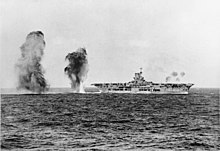Sea battle at Cape Teulada
| date | November 27, 1940 |
|---|---|
| place | south of Sardinia , Italy |
| output | tactical tie |
| Parties to the conflict | |
|---|---|
| Commander | |
| Troop strength | |
| 2 battleships 6 heavy cruisers 14 destroyers |
1 aircraft carrier 1 battleship 1 battle cruiser 1 heavy cruiser 5 light cruiser 1 anti-aircraft cruiser 14 destroyers 4 corvettes 4 cargo ships |
| losses | |
|
1 destroyer badly damaged |
1 heavy cruiser slightly damaged |
The sea battle at Cape Teulada , also known as the sea battle at Cape Spartivento , was fought south of Sardinia on November 27, 1940 between the Italian Navy ( Regia Marina ) and the British Royal Navy . It was a minor sea battle lasting just under an hour with only minor losses on both sides.
background
On November 11, 1940, a good two weeks before the naval battle , the British had put almost half of the Italian battle fleet out of action in a successful air raid on the Italian naval base in Taranto . The British then planned to send a larger convoy from Gibraltar to Malta and on to Alexandria . On November 17, an Italian naval association with the two battleships Vittorio Veneto and Giulio Cesare escaped a first British convoy that was supposed to bring planes to Malta. The British leadership warned of the Italian naval association, whereupon the British convoy returned to Gibraltar. Then a new convoy with considerable additional security was put together by forces from Gibraltar and Alexandria ( Force H and Force D ). In this case too, the Italians tried to intercept the convoy.
Course of the battle
The British were largely informed about the Italian naval movements and sent their naval formations under the leadership of Admiral James Somerville to forestall an attack on the convoy. On November 27, 1940 at 11:45 a.m. they received the information that the Italian fleet, led by Admiral Inigo Campioni , was only about 50 nautical miles away. The Italians had the two battleships Vittorio Veneto and Giulio Cesare , plus 6 heavy cruisers and 14 destroyers . The two British naval associations consisted of the aircraft carrier HMS Ark Royal , the battleship HMS Ramillies , the battle cruiser HMS Renown and 7 cruisers (1 heavy , 5 light and 1 anti-aircraft cruiser ), 14 destroyers and 4 corvettes , which escorted 4 cargo ships.
From 12:07 p.m. the Italian cruisers started the battle, at 12:22 p.m. the fire fight between the two cruiser formations began when the Italian cruiser Fiume opened fire from 23,500 m. From 12:26 p.m. onwards, after a few volleys , the HMS Ramillies was de facto eliminated from the battle because of its insufficient speed. The combat distance between the cruiser formations was getting smaller and smaller, with the Italians gradually being able to bring their superior firepower to bear in this situation. At 12:30 p.m., the commanding officer of the Italian cruiser formation, Vice Admiral Angelo Iachino , received the order to retreat, although he had a slight advantage. At that time, the Italian destroyer Lanciere was badly damaged by a volley from the British light cruiser HMS Manchester , while the heavy cruiser HMS Berwick received two hits, which, however, caused only minor damage.
After that first battle, the British had a slight advantage, but this was offset at 1:00 p.m. by the arrival of the new Italian battleship Vittorio Veneto . The Vittorio Veneto fired seven salvos at the opposing cruiser formation from a great distance, whereupon the British broke off the fight and both sides withdrew after a total of 54 minutes of fighting and minor losses.
meaning
The sea battle at Cape Teulada ended in a tactical draw. Only the number of vessels involved justifies the designation battle for this from the perspective of both sides unsatisfactory runny sea battle . The Italian aerial reconnaissance proved to be too weak and imprecise to be able to use its own advantages.
literature
- Elmar B. Potter, Chester W. Nimitz : Sea power. A history of naval warfare from antiquity to the present. German version published by Jürgen Rohwer on behalf of the Defense Research Working Group . Bernard and Graefe, Munich 1974, ISBN 3-7637-5112-2 .
Individual evidence
- ↑ Elmar B. Potter, Chester W. Nimitz: Seemacht. 1974, p. 581 f.

